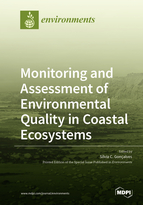Monitoring and Assessment of Environmental Quality in Coastal Ecosystems
A special issue of Environments (ISSN 2076-3298).
Deadline for manuscript submissions: closed (28 May 2021) | Viewed by 18789
Special Issue Editor
Interests: biodiversity and ecosystem functioning; environmental risk; aquaculture and fisheries; biotechnology and resources valorization
Special Issues, Collections and Topics in MDPI journals
Special Issue Information
Dear Colleagues,
Coastal ecosystems are dynamic, complex, and often fragile transition environments between land and oceans. They are exclusive habitats for a broad range of living organisms, function as havens for biodiversity and provide several important ecological services that link terrestrial, freshwater, and marine environments.
Humans living in coastal zones have been strongly dependent on these ecosystems as a source of food, physical protection against storms and the advancing sea, and a range of human activities that generate economic income (e.g., tourism and water sports). Notwithstanding, the intensification of human activities in coastal areas of the last decades, as well as the global climatic changes and coastal erosion processes of the present, have introduced detrimental impacts on these environments. Organic and inorganic pollution, marine anthropogenic litter, destruction, and fragmentation and modification of habitats for multiple purposes, overexploitation of natural resources, introduction of invasive species and loss of biodiversity are among the most common impacts. Maintaining the structural and functional integrity of these environments, as well as recovering an ecological balance or mitigating disturbances in systems under the influence of such stressors, are complex tasks, only possible through the implementation of monitoring programs and by assessing their environmental quality.
In this Special Issue, I invite colleagues to contribute original research papers and review articles on all aspects of environmental quality monitoring and assessment of coastal ecosystems, with a focus on biotic or abiotic compartments (or both) and using tools that may range between ecological levels of organization from individuals to the ecosystem.
Dr. Sílvia C. Gonçalves
Guest Editor
Manuscript Submission Information
Manuscripts should be submitted online at www.mdpi.com by registering and logging in to this website. Once you are registered, click here to go to the submission form. Manuscripts can be submitted until the deadline. All submissions that pass pre-check are peer-reviewed. Accepted papers will be published continuously in the journal (as soon as accepted) and will be listed together on the special issue website. Research articles, review articles as well as short communications are invited. For planned papers, a title and short abstract (about 100 words) can be sent to the Editorial Office for announcement on this website.
Submitted manuscripts should not have been published previously, nor be under consideration for publication elsewhere (except conference proceedings papers). All manuscripts are thoroughly refereed through a single-blind peer-review process. A guide for authors and other relevant information for submission of manuscripts is available on the Instructions for Authors page. Environments is an international peer-reviewed open access monthly journal published by MDPI.
Please visit the Instructions for Authors page before submitting a manuscript. The Article Processing Charge (APC) for publication in this open access journal is 1800 CHF (Swiss Francs). Submitted papers should be well formatted and use good English. Authors may use MDPI's English editing service prior to publication or during author revisions.
Keywords
- coastal ecosystems
- environmental quality and environmental indexes
- monitoring and/or assessment programs
- environmental disturbances
- pressures and stressors
- anthropogenic impacts
- bioindicators
- biomonitors
- ecotoxicology and biomarkers
- populations
- communities and ecosystem responses






